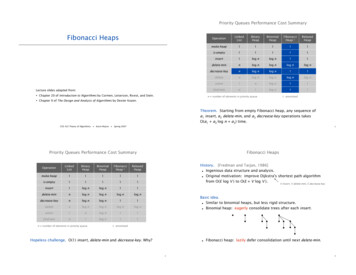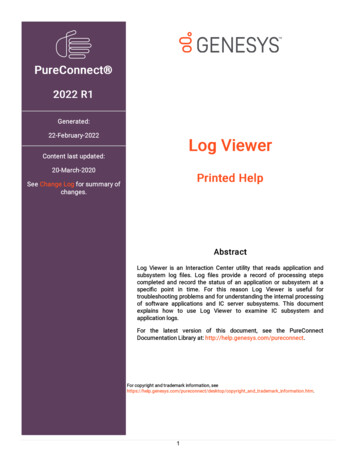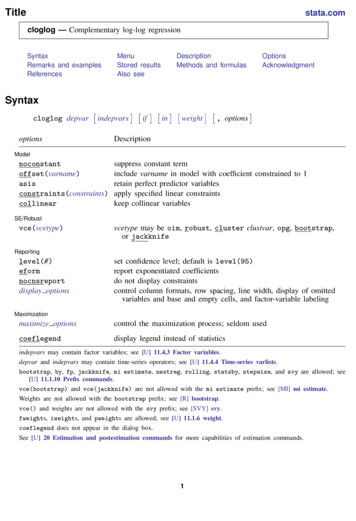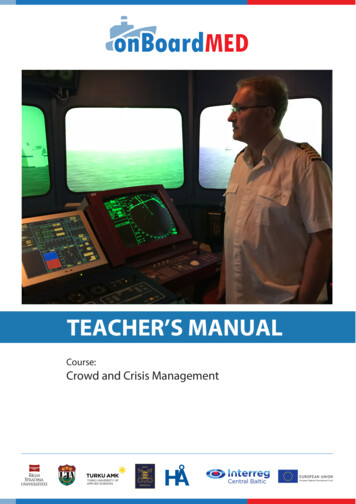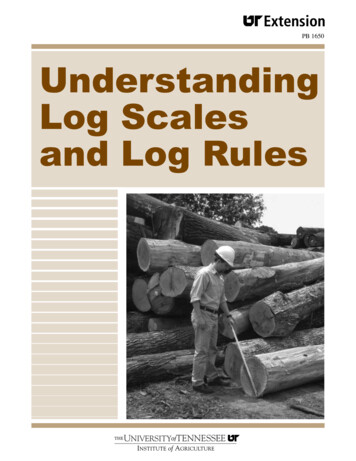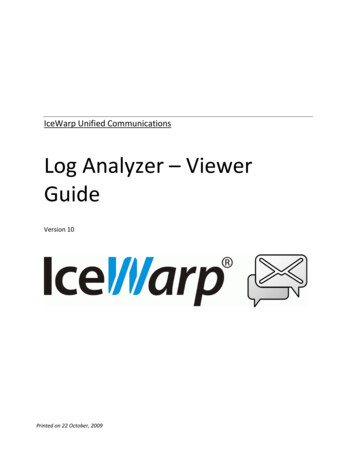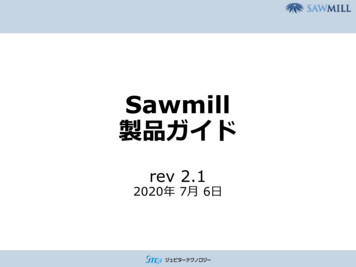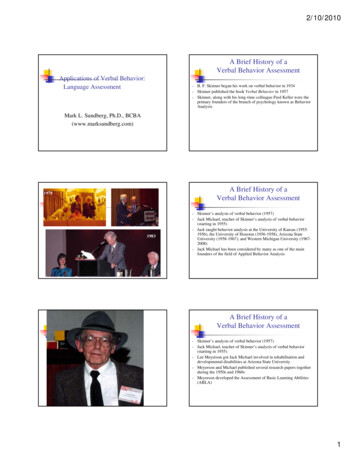
Transcription
2/10/2010A Brief History of aVerbal Behavior AssessmentApplications of Verbal Behavior:Language Assessment B. F. Skinner began his work on verbal behavior in 1934Skinner published the book Verbal Behavior in 1957Skinner, along with his long-time colleague Fred Keller were theprimary founders of the branch of psychology known as BehaviorAnalysisMark L. Sundberg, Ph.D., BCBA(www.marksundberg.com)1978A Brief History of aVerbal Behavior Assessment1993 1983 Skinner’s analysis of verbal behavior (1957)Jack Michael, teacher of Skinner’s analysis of verbal behavior(starting in 1955)Jack taught behavior analysis at the University of Kansas (1955(19551956), the University of Houston (1956-1958), Arizona StateUniversity (1958-1967), and Western Michigan University (19672008)Jack Michael has been considered by many as one of the mainfounders of the field of Applied Behavior AnalysisA Brief History of aVerbal Behavior Assessment Skinner’s analysis of verbal behavior (1957)Jack Michael, teacher of Skinner’s analysis of verbal behavior(starting in 1955)Lee Meyerson got Jack Michael involved in rehabilitation anddevelopmental disabilities at Arizona State UniversityMeyerson and Michael published several research papers togetherduring the 1950s and 1960sMeyerson developed the Assessment of Basic Learning Abilities(ABLA)1
2/10/2010A Brief History of aVerbal Behavior Assessment Skinner’s analysis of verbal behavior (1957)Jack Michael, teacher of Skinner’s analysis of verbal behavior(starting in 1955)Lee Meyerson got Jack Michael involved in rehabilitation anddevelopmental disabilities at Arizona State University. Theypublished several papers togetherMontrose Wolf was Jack Michael’s second Ph.D. student at ArizonaState University, and along with Don Baer and Todd Risley providedthe foundation for modern Applied Behavior Analysis (Baer, Wolf,Risley, 1968), and behavioral autism treatment (Wolf, Risley, &Mees, 1964), later called DTT/ABA. Montrose Wolf founded JABAand was the first Editor of that journalDon Baer, Mont Wolf, & Todd RisleyA Brief History of aVerbal Behavior Assessment Skinner’s analysis of verbal behavior (1957)Jack Michael, teacher of Skinner’s analysis of verbal behavior(starting in 1955)Lee Meyerson got Jack Michael involved in rehabilitation anddevelopmental disabilities at Arizona State University. Theypublished several papers togetherMontrose Wolf was Jack Michael’s second Ph.D. student at ArizonaState University, and along with Don Baer and Todd Risley providedthe foundation for modern Applied Behavior AnalysisJoseph Spradlin, was the first to systematically apply Skinner’sanalysis of verbal behavior to language assessment (andintervention)“The Parsons Language Sample” (1963)Joe Spradlin at the 1979 ABA Convention (Poster on the Intraverbalby Steve Braam, et al.)2
2/10/2010A Brief History of aVerbal Behavior Assessment The Purpose of a Language Assessment“The Parsons Language Sample” (1963) by Joe SpradlinThe Purpose of a Language AssessmentThe Purpose of a Language AssessmentA Brief History of aVerbal Behavior AssessmentThe Purpose of a Language Assessment During the 1960s and 1970s there were 100s ofpeople who contributed to the development ofA li d BehaviorAppliedB h i AnalysisA l i andd languagelassessment and intervention for thedevelopmentally disabled (e.g., Baer, Bailey, Bijou,Englemann, Guess, Hart, Kent, Lovaas, Lutzker,Risley, Sailor, Sherman, Spradlin, Terrace,Touchette, Wolf )3
2/10/2010A Brief History of aVerbal Behavior Assessment There was also a number of behavior analysts focusing onSkinner’s analysis of verbal behavior (e.g., Catania, Cook,Day, Ferster, Holland, Knapp, MacCorquodale, Michael,Moore Pear,Moore,Pear SalzingerSalzinger, SpradlinSpradlin, SloaneSloane, Vargas,Vargas WoodWood ))During the 1970s approximately 50 VB research projectswere conducted at the Kalamazoo Valley MultihandicapCenter (KVMC) under the direction of Jack Michael, MarkSundberg, and Jerry ShookMost of these projects were WMU Masters theses andDoctoral dissertations, and were also presented at MABAand ABA conventionsSteve Braam, Cassie Braam, Mark Stafford, Tom Rueber, DaveRay, & Mark Sundberg at the ABA Convention, 1979 (workshop)First version of the ABLLS & VB-MAPP1978Jack Michael, Ivar Lovaas, & Mark Sundberg, ABAConvention, 1979 (Poster on automatic reinforcement)1993 ThThe ABLLS by Partington &Sundberg, 1998. The earlierSundberg books were split intotwo books, one on assessmentand one on intervention.1983Sundberg 1987 VB Assessmentand Intervention ManualSundberg 1990 VB Assessmentand Intervention ManualFirst version4
2/10/2010www.AVBPress.comVB-MAPP by Mark Sundberg,2008ASR #1 The university professor who has beenthe primary teacher of Skinner’sanalysis of verbal behavior over thepast 50 years is:1.2.3.4.Murray SidmanNate AzrinOgden LindseyJack MichaelASR #2 The clinical researcher who was the firstto apply Skinner’s analysis of verbalbehavior to language assessment forthe developmentally disabled was:1.2.3.4.Joseph SpradlinDon BaerJerry ShookMontrose WolfASR #3 During the 1970s Jack Michael was theresearch advisor for over 50 verbalbehavior research projects conductedat:1.2.3.4.Parsons State HospitalJuniper GardensThe New England Center for AutismThe Kalamazoo Valley MultihandicapCenterApplications of Verbal Behavior:Language AssessmentMark L. Sundberg, Ph.D., BCBA(www.marksundberg.com)5
2/10/2010The Purpose of a Language AssessmentDetermine the operant level of a child’s verbal (and related) skillsCompare to typical language development dataIdentify language acquisition and learning “barriers”If and where to begin intervention (placement)Establish IEP goalsDesign an individualized curriculum/intervention programTeaching strategies (e.g., AC, DTT-NET, inclusion, in-home)Is the intervention program working? Why or why not?A tool to demonstrate learning, track progress, make changes,provide outcome measures Behavioral Language AssessmentTraditional Language Assessment Cognitive and/or biological variables seen as the primarysources of control for verbal responsesBased on the expressive-receptive distinction, mediated bycognitivegprocessorspNorm referenced and standardized assessmentsPeabody Picture Vocabulary TestExpressive One-word Vocabulary TestWechsler Preschool and Primary Scale of IntelligenceClinical Evaluation of Language FundamentalsPreschool Language ScalesASR #4 The verbal operant is the functional unit (form and function)Environmental variables are viewed as the relevant sources ofcontrol for verbal responses, rather than cognitive or biologicalvariablesEach verbal operants involves separate sources of control(independent variables), thus each must be assessedMost verbal responses are under multiple sources of controlMore complex verbal behavior is comprised of variouscombinations of the verbal operantsSpeaker and listener as separate repertoiresCriterion-referenced assessmentASR #5 Skinner’s analysis of verbal behaviorproposes that the unit of analysis in themeasurement of language should be:1.2.3.4.The mean length of utteranceThe phrase structureThe nt and punishmentThe application of Skinner’s analysis ofverbal behavior to language assessmentsuggests that:Language should be assessed by acceptedABA proceduresLanguage should be assessed by itsfunctional propertiesLanguage should be assessed in terms of itsform and functionLanguage should be assessed in the naturalenvironment1.2.3.4.ASR #6 In addition to assessing the elementaryverbal operants, it is also important toanalyze and assess:1.2.3.4.All cognitive variables related to languagedevelopmentThe linguistic barriers that may bepreventing verbal developmentThe intraverbal repertoire in great detailThe mand repertoire in great detail6
2/10/2010ASR #7 ASR #8The problem with assessment based onthe traditional distinction betweenexpressive and receptive language is that:11.2.3.4. It takes too long to assess all the skillsThe categories of expressive and receptiveblend important distinctions between mand,tact, intraverbal, and listener skillsThere is no distinction between expressiveand receptive languageExpressive and receptive language do notaccount for sign language and picturesystems11.2.3.4.ASR #9 A standardized language assessmentis:11.2.3.4.Criterion referencedBoth norm referenced and criterionreferencedNorm referencedNeither norm referenced or criterionreferenced The verbal operant is the functional unit (form and function)Environmental variables are viewed as the relevant sources ofcontrol for verbal responses, rather than cognitive or biologicalvariablesEach verbal operants involves separate sources of control(independent variables), thus each must be assessedMost verbal responses are under multiple sources of controlMore complex verbal behavior is comprised of variouscombinations of the verbal operantsSpeaker and listener as separate repertoiresCriterion-referenced assessmentThe Importance of Language andSocial Behavior The primary focus of an intervention program for children withautism should be on the development of effective language andsocial skillsThere clearly are several other areas in need,need such self-careself-care,visual motor skills, academics, fine and gross motor, etc., butlanguage and social skills are typically the most significantdeficits for children with autism, and careful training is the keyto the most significant gainsThe failure to conduct an appropriate assessment results in oneof the biggest problems in programs that serve children withautism or other developmental disabilities: An inappropriatecurriculumResponse form, meanmean-length-oflength ofutterance, and age equivalentsSpeech onlyCognitive growthArticulation and communication errorsBehavioral Language Assessment The focus of traditional languageassessment is on:The Behavioral Classificationof Language (Skinner, 1957) Mand: Asking for reinforcers. Asking for “shoes” because youwant your shoesTact: Naming or identifying objects, actions, events, etc.Saying “shoes” because you see your shoesListener: Following instructions or complying with the mandsof others. Touching a picture of shoes when asked “Touch theshoes”Echoic: Repeating what is heard. Saying “shoes” aftersomeone else says “shoes”7
2/10/2010The Behavioral Classificationof LanguageProblems with the ABLLS(Partington & Sundberg, 1998) Imitation: Copying someone’s motor movements (as they relate tosign language)Copying-a-text:py gWritingg “shoes” because someone else writes“shoes”Intraverbal: Answering questions or having conversations whereyour words are controlled by other words. Saying “shoes” becausesomeone else says “What do you need to put on your feet?”Textual: Reading words. Saying “shoes” because you see thewritten word “shoes”Transcription: Writing and spelling words spoken to you. Writing“shoes” because you hear “shoes” spoken ASR #10 ASR #11An assessment based on verbalbehavior assesses:11.2.3.4. All of the elementary verbal operants andother language related skills such asmatching, social behavior, play skills, andlistener skillsOnly the verbal operantsThe linguistic structure of EnglishExpressive and receptive language2.3.4. Not a “curriculum” for language intervention: “curriculum guide”Originally, the ABLLS was designed to accompany the “TeachingLanguage to Children with Autism” book (The ABLLS was notgto serve as a stand alone pproduct))designedNot enough information in the individual cells to explain the skillbeing assessed and the relevant sources of control (e.g., noun-verbtacting, mands for information, multiply controlled intraverbalbehavior)No verbal behavior analysis of language and learning barriers (amajor component of assessment)No placement system (e.g., when to start IV)No transition assessmentSelf-injurious or aggressive behaviorAn inappropriate language and socialskills curriculumThe need for more extensive servicesA less expensive programVerbal Behavior Milestones Assessmentand Placement Program:The VB-MAPP(Partington & Sundberg, 1998) The failure to adequately assess achild’s language and related skills, andhis language and learning barriers oftenresults in:1.Problems with the ABLLS A significant improvement over Spradlin, 1963; Sundberg, et al,1979; Sundberg, 1983, 1987, 1990Too many skills to assess (476, over 1500 cells with the 1-4 criteria)Steps in the cells were too small for IEP goals (Milestones are better)Skills not developmentally balanced out on the gridsMuch of it is out of developmental sequence (as I see it now)Core sequence of verbal skills is 26 years old (Sundberg, 1983)Just a listing of skills with examples, and a scoring criteriaConfusing progression of skills; up or out?No content on what constitutes mands, tacts, intraverbals, etc.No content/text on how to conduct a verbal behavior analysis Based on Skinner’s (1957) analysis of verbal behaviorBased on typical language development milestonesAn assessment should probe a representative sample of arepertoireiTypical verbal milestones provide the frame for the sampleBy identifying milestones, as opposed to a whole taskanalysis, the focus can be sharper, the direction clearerMilestones can help to avoid focusing on minor steps, andtargeting skills for intervention that are developmentallyinappropriate8
2/10/2010Verbal Behavior Milestones Assessmentand Placement Program:The VB-MAPPVerbal Behavior Milestones Assessmentand Placement Program:The VB-MAPP Field test data from approximately 75 typically developingchildrenFi ld test dataFieldd fromfover 200 childrenhildwithi h autismiBased on the body of empirical research that provides thefoundation of Behavior AnalysisBased on the empirical research on Skinner’s analysis ofverbal behaviorVerbal Behavior Milestones Assessmentand Placement Program:The VB-MAPP The VB-MAPP: Skills Task Analysis and Tracking provides afurther breakdown of the different skill areas in the form of achecklist for skills trackingThe VB-MAPP: Placement and IEP Goals providesrecommendations for program development for children based ontheir VB-MAPP profiles, and their specific scores for each of the170 milestones and the 24 Barriers. In addition, over 200 IEPobjectives directly linked to the skills and barriers assessments, anda verbal behavior intervention program are provided There are five components of the VB-MAPPThe VB-MAPP: Milestones Assessment contains 170 verbalbehavior milestones across 3 developmental levels (0-18 months,18-30 monthsmonths, 30-48 months) and 16 different verbal operants andrelated skillsThe VB MAPP: Barriers Assessment examines 24 commonlearning and language barriers faced by children with autismThe VB MAPP: Transition Assessment evaluates a child’s abilityto learn in a less restrictive educational environment across 18different skillsASR #12 The Verbal Behavior MilestonesAssessment and Progress Program (VBMAPP) is based on:1.2.3.4.ASR #13 The Verbal Behavior MilestonesAssessment and Progress Program (VBMAPP) is designed to:1.2.3.4.Assess language and social skills, andassess learning, language, and socialimpairmentsAssess language skillsAssess behavior problemsAssess linguistic structureThe linguistic framework developed byDr. Roger BrownDiscrete trial and ABA instructionalmethodologyDevelopmental linguisticsSkinner’s analysis of verbal behavior andtypical language development milestonesASR #14 The VB-MAPP Milestones Assessmentcovers the language skills of a typicallydeveloping child:1.2.3.4.Between 0Between 0Between 0Between 4totototo10 years old4 years old2 years old6 years old9
2/10/2010Verbal Behavior Milestones Assessmentand Placement Program:The VB-MAPPASR #15 By using “milestones” as a measure inassessment rather than individual skillsfrom a task analysis, the interventionprogram1.2.3.4.The VB-MAPP: Skills Task Analysis and Tracking provides afurther breakdown of the different skill areas in the form of achecklist for skills trackingThe VB-MAPP: Placement and IEP Goals providesrecommendations for program development for children based ontheir VB-MAPP profiles, and their specific scores for each of the170 milestones and the 24 Barriers. In addition, over 200 IEPobjectives directly linked to the skills and barriers assessments, anda verbal behavior intervention program are provided Does not require reliability and validity measuresRequires more data collectionTakes longer to implementCan be better focused on long-term goals and aclearer direction for the overall interventionprogramVerbal Behavior Milestones Assessmentand Placement Program:The VB-MAPP Skills Assessment The 16 skills assessed on the VB-MAPP include:The elementary verbal operants (e.g., echoic, mand, tact, intraverbal)The listener skillsVocal outputIndependent playSocial skills and social playVisual perceptual skills and matching-to-sampleGrammatical and syntactical skillsGroup and classroom skillsBeginning academic skillsVerbal Behavior Milestones Assessmentand Placement Program:The VB-MAPP Skills Assessment The milestones are broken into three developmental levels (see Skills Form)Level 1: 0-18 monthsLevel 2: 18-30 monthsLevel 3: 30-48 monthsThe scores for each skill are approximately balanced across each levelThere are 5 items and 5 possible points for each skill area (e.g., level 1, tact)There are three boxes in all sections for three separate administrations(See Tact Assessment Form Sample)Each of the 170 items is scored 0, 1, or 1/2 based on the criteria in theVB-MAPP instruction manualLooking for the operant level; If the skill is below the operant level scorequickly and move on, if it is close to the operant level, test it10
2/10/2010ASR #16 By balancing out the verbal operantsbased on typical languagedevelopment:1.2.3.4.ASR #17 Many of the early language skillsemitted by typically developing childrenare:1.2.3.4.ASR #18 Under one source of controlHard to measureExpressions of cognitive functionsMultiply controlled by both MOs and SDsWhen the VB-MAPP Master ScoringForm is completed, a visual review ofthe form:1.2.3.4.VB-MAPP Level 1: TactYou cannott ttellll whenYh tot startt t iintraverbaltb l ttrainingi iIt’s hard to compare the rate of tact acquisitionto mand and intraverbal acquisitionThe level of each skill can be easily visuallycompared to the other verbal operants and therelated skillsYou cannot account for splinter skillsCan reveal approximate verbal age levels,strengths and weaknesses, and if theskills are in balance when compared toeach otherCan tell you a child’s chronological ageCan identify if the child has autismCan be used in litigationASR #19 The VB-MAPP Milestones Assessmentshould be conducted:11.2.3.4.Every monthOnce a yearWeeklyEvery three years11
2/10/2010Verbal Behavior Milestones Assessmentand Placement Program:The VB-MAPP Skills AssessmentVB-MAPP Level 1: TactThe total for the five items is marked on the top of each skill areaThe totals for each skill area are added for all three levels andplaced on the VB-MAPP Scoring FormThe total score on the Echoic sub-test is converted to a milestonescore on the VB-MAPP formThe specific items on the VB-MAPP have been adjusted manytimes based on the field-test data (See VB-MAPP AssessmentForms) Verbal Behavior Milestones Assessmentand Placement Program:The VB-MAPP Barriers AssessmentThe Early Echoic Skills AssessmentIt is important to find out what a child can do (The VB-MAPPMilestones Assessment), but also important to know what they can’tdo, and analyze why they can’t do itThe VB-MAPP Barriers Assessment is a tool that is designedgtoidentify and score 24 different learning and language acquisitionbarriersOnce a specific barrier has been identified, a more detaileddescriptive and/or functional analysis of that problem is requiredThere are many ways that a verbal repertoire or related skill canbecome defective, and an individualized analysis will be necessary todetermine what the nature of the problem is for a specific child, andwhat intervention program might be appropriate Verbal Behavior Milestones Assessmentand Placement Program:The VB-MAPP Barriers Assessment Defective Verbal BehaviorA descriptive functional analysis of verbal behavior (Skinner, Chap 1)A behavioral analysis of words, phrases, and sentences emitted bychildren with autismSame basic principles of behavior as nonverbal behaviorWhat is the source of control?These sources of control will often reveal that what appears to be acorrect response in form is actually incorrect in functionMight not be the same source of control observed in a typicallydeveloping child (e.g., What’s your name?)Each verbal operant can be susceptible to unwanted sources of controlVerbal Behavior Milestones Assessmentand Placement Program:The VB-MAPP Barriers Assessment Defective mands (I want candy. What’s that?)Defective tacts (Bounce ball, Black car, Under table)Defective intraverbal responses (Poopies evoked by What do yousmell in the oven?)The behavior analyst must determine what the correct source ofcontrol should be, and how that source can be establishedThe functional analysis of verbal behavior is on-goingThe failure to conduct such an analysis may result in rote ordefective verbal repertoires that can become difficult to changeThis is how behavior analysis is different, this is what we do asbehavior analysts12
2/10/2010Verbal Behavior Milestones Assessmentand Placement Program:The VB-MAPP Barriers Assessment Verbal Behavior Milestones Assessmentand Placement Program:The VB-MAPP Barriers AssessmentCommon Learning and Language Acquisition BarriersInstructional control (Escape/avoidance)B h i problemsBehaviorblDefective mandDefective tactDefective motor imitationDefective echoic (e.g., echolalia)Defective matching-to-sampleDefective listener repertoires (e.g., LD, LRFFC) Verbal Behavior Milestones Assessmentand Placement Program:The VB-MAPP Barriers Assessment Common Learning and Language Acquisition Barriers Weak or atypical MOsRResponserequirementsit weakensktheth MOSelf-stimulationArticulation problemsObsessive-compulsive behaviorReinforcement dependentDoes not make eye contactSensory defensivenessDefective intraverbalD f ti playDefectivel andd sociali l skillskillPrompt dependent, long latenciesScrolling responsesDefective scanning skillsFailure to make conditional discriminations (CDs)Failure to generalizeHyperactivityVerbal Behavior Milestones Assessmentand Placement Program:The VB-MAPP Barriers Assessment Common Learning and Language Acquisition Barriers Scoring the VB-MAPP Barriers FormRate the child on the VB-MAPP Barriers Assessment Form using aLikert-type scale of 0 to 4A score of 0 or 1 would indicate that there are no significantbarriers, and a formal intervention plan may not be required.A score of 2, 3, or 4 would indicate that there is a barrier, thatprobably should be addressed as part of the intervention programFor some children the immediate focus of the intervention programis on removing a particular barrier, rather than language instructionThe most common immediate barriers to remove involveinstructional control problems, or other behavior problems13
2/10/2010The VB-MAPP:Transition Assessment A common goal for many educators and parents of children with special needs is tointegrate the child into a mainstream settingThere are many different levels of integration and the Transition Assessment wasdesigned to identify the skills that increase the probability that a child will besuccessful in a less restrictive settingNo single skill will be a good determiner of success, but a collective body of skillscan help educators and parents make decisionsThe VB-MAPP Transition Assessment provides a tool to help determine if a childhas the necessary prerequisite skills to learn in a less restrictive classroomenvironmentThere are 18 skill areas on the Transition Assessment14
2/10/2010ASR #20 ASR #21The Early Echoic Skills Assessment(EESA) was developed by:11.2.3.4.The scores from the Early Echoic SkillsAssessment (EESA): 1.Jack Michael, Ph.DJose Martinez-Diaz, Ph.D.Barbara Esch, Ph.D., CCC-SLPMark Sundberg, Ph.D.2.3.4.ASR #22 ASR #23A child with ASD might emit a responsethat has the same form as that of atypically developing child (e.g., asking“What’s your name?”), but:1.2.3.4.The responseThe responseThe responseThe responsefunctionIf a child meets a particular milestonehe is given:11.2.3.4.10 points1 point½ pointNo points If a child meets a particular milestone:1.2.may be echolalicmay be a mand and a tactmay be promptedmay occur for the wrongASR #24 Should be added together and convertedaccording to the formula described in the echoicsection of the Milestones AssessmentAre not included in the child’s overall scoreCan tell you the child’s ageHelp to identify the need for mand training3.4.Begin taking baseline data on the nextmilestoneBegin an intervention program on thatmilestoneThe related box on the VB-MAPP MasterScoring Form should be shaded inThe assessment is finishedASR #25 Points are added together for each skillarea then:1.2.3.4.Points from all the skill areas are added togetherand pplaced in the “score” box on the VB-MAPPMaster Scoring FormPoints are not used in any significant mannerPoints for the verbal skills are doubled andadded to the other areasPoints for each skill area should be graphedusing a cumulative recording system15
2/10/2010ASR #26 If a child fails to obtain any points onthree milestones in a row in a specificskill area:1.2.3.4.The VB-MAPP Barriers Assessment usesa Likert scale designed to identify:11.2.3.4.Many children with autism:1.22.3.4.Are affected by 1 or 2 barriersAre not affected by barriersMay be affected by 5 or more barriersAre affected by all the barriersThe best results from a VB-MAPPAssessment are obtained by someonewho:11.2.3.4.Knows the child wellIs formally trained in behavior analysis, Skinner’s analysisof verbal behavior, and has a working knowledge of basiclinguistic structure and grammarAny professional who is responsible for developing andmonitoring the educational program for a particular childIs a Board Certified Behavior AnalystASR #29 Potential language and learning problemsthat are preventing a child from makinggreater gainsHow long it takes to acquire new skillsExpressive and receptive languagebarriersHow to transition a child to a lessrestrictive environmentASR #30 Go back and re-test each skillEnd the assessment on that skill areaObtain a reliability measureBegin the intervention programASR #28 ASR #27Once a barrier has been identified onthe Likert scale the next step is to:11.2.3.4.Write a reportConduct the VB-MAPP transitionAssessmentDesign a punishment procedure for themost intrusive barrierConduct a descriptive or functionalanalysis of the problemASR #31 The main task in identifying the natureof a barrier is to:11.2.3.4.Determine the child’schild s intentionsConduct a psychological testIdentify the sources of antecedent andconsequent controlObtain content for a written report16
2/10/2010ASR #32 Barriers are common for children withlanguage delays and often:11.2.3.4.An impaired matching-to-samplerepertoire may be related to:11.2.3.4. Only the tact is affected by barriersOnly matching-to-sample is affected bybarriersRemoving the barrier should be theimmediate focus of the interventionprogramThe barrier will go away by itselfASR #34 ASR #33An impaired mand may bedemonstrated by:11.2.3.4.ASR #35 Defective cognitive processingA low IQApraxiaThe failure to scan the visual arrayAn impaired tact repertoire may be dueto:11.2.3.4.ASR #36 The VB-MAPP Transition Assessmentwas designed to:1.2.3.4.Determine if a child can move wellbetween teaching sessionsBe used in litigation and fair hearingsProvide some data for making decisionsregarding the type of educationalprogram that might best benefit a childDetermine if a child needs verbalbehavior trainingThe same word or sign (e.g., “more”)more )being used for all sources of motivationA mand that is only controlled bymotivationA mand that occurs spontaneouslyA mand that does not stop until it getsreinforcedFailing to teach matching-to-samplematching to samplerepertoireTeaching verbs, adjectives, andprepositions before tacts of nouns arewell establishedPoor cognitive processingAphasiaASR #37 The VB-MAPP Transition Assessmentcovers:11.2.3.4.Only the summed scores from theMilestones and the Barriers AssessmentScores for 18 different skill areasA summation of all assessments from athree-year evaluationA functional analysis of behaviorproblems17
2/10/2010The VB-MAPPTask Analysis and Skills Tracking The milestones can be considered floors in a building, and the taskanalysis contains the steps between each floorThere are 170 milestones and approximately 900 total tasks in theVB-MAPP task analysisyThe task analysis form also allows for more detailed skills trackingBuilding a whole repertoire, not just individual skills (e.g., mand,tact, M-T-S repertoires)18
2/10/2010ASR #38 The VB-MAPP Transition Assessment isscored by using:11.15 b15-b2.3.4.ASR #39 The most important part of transitioninga child to a less restrictive environmentis that:1.2.3.4.The new environmentThit isi theth leastlt expensiveiThe new environment results in the mosteffective learning possible for a childThe new environment has the least amount ofsupportThe new environment does not contain any ABAtherapyA Likert type scaleConverted IQ scoresThe results of a functional analysisThe results of a speech and languageevaluationASR #40 The decision to place a child in a leastrestrictive setting is the soleresponsibility of:1.2.3.4.The classroom teacher along with aBoard Certified Behavior AnalystSchool district administratorsThe child’s parentsThe IEP team as a wholeVerbal Behavior Milestones Assessmentand Placement Program:IEP Goals and Placement The re
Mark L. Sundberg, Ph.D., BCBA (www.marksundberg.com) A Brief History of a Verbal Behavior Assessment B. F. Skinner began his work on verbal behavior in 1934 Skinner published the book Verbal Behavior in 1957 Skinner, along with his long-time colleague Fred Keller were the
